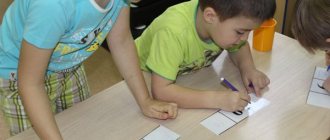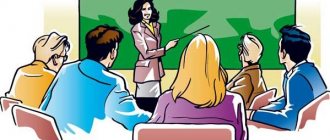Features of a child with ODD level I, ODD level II. Alalia (organization of RPPS, working methods)
Author: Tatyana Aleksandrovna Korekova , Category: Consultations for teachers · 2/2/2018 12:57:00
Good afternoon, dear teachers. At the first meeting, Olga Valerievna talked about children with disabilities and disabilities. The group of children with disabilities is not homogeneous; it includes children with various developmental disorders, the severity of which may vary. Let us remember what developmental disorders such children have.
Read all »
TRIZ Saturday No. 13: Master class on using the little people method
18/1/2017
Hello readers!
And one more story about the next “TRIZ Saturday”. This time we tried a new format: a master class on TRIZ methods. In one lesson, we get acquainted with some method, use it to solve some scientific problem, and then try to solve some of our own life problems using this method.
The point: to make each lesson complete and unrelated to the other, so that both children who came for the first time and “old-timers” could participate.
We had our sights set on the method of little men - MMC. Using this method, you can represent any object, their system or even a process. The key word here is REPRESENT. Often the words atoms and molecules do not convey a clear visual image, especially for children. In addition, the participation of little people greatly reduces psychological inertia: their very appearance is already a little fabulous and unusual. Therefore, many people relax and begin to think in ways that they would never do if they imagined atoms and molecules.
Introduction to the MMC method:
The most enjoyable and interesting game for children is to turn into these little people themselves - liquid, solid or gaseous.
We immediately tried to model some processes with the schoolchildren:
- “plunging” a finger into the table
- dipping your finger in water,
- immersion in an empty glass of air.
Many inventors came up with something when they began to observe the process not from the outside, but imagined it and became a full-fledged participant. This is a very useful exercise for children, developing the ability to imagine and think in images.
The next way to introduce people is to draw them. Here I encountered a difficulty: drawing objects with the help of little people was difficult for many. Many people slipped into drawing a non-homogeneous substance, rather than people. For me, this means that not everyone understood the meaning and what advantage is presented by the presentation of men, and not bricks, for example. This means that this advantage must be shown very, very clearly.
The culmination of our master class was an experiment that we tried to understand and explain with the help of little people. Quite simple, but it was the one that was supposed to push the guys to the right reasoning when solving the next problem.
Experiment #1:
They took some water into the bag and tied it tightly. Put it in a jar and pierce the bag. As a result, the water first begins to flow out like a fountain, and then stops. Why?
With little people, this experiment is explained very simply and, most importantly, is understandable for children.
At first, the little men feel very cramped in the bag of water. It looks like a stuffy room with a lot of people crammed into it. Everyone wants to go out. And when they open the door (they make a puncture), those little men who are standing nearby immediately begin to get out. And those standing far from the entrance are waiting for their turn. But at some point, the little people outside become as cramped as the ones inside. There is no point in going out anymore and the little people stop coming out of the bag.
Communicating vessels, pressure - all this will be studied only in high school in physics lessons. But now it is already possible to explain many processes to children in an accessible language, and most importantly, GIVE them a tool with which they can explain many things around them. And one more thing: then, after 5-6 years in physics lessons, all these processes and formulas will not only be memorized by children, but will be understood on an absolutely natural level.
Experiment No. 2
Throw a small paper ball into a glass of water. We pour water from glass to glass and the ball also moves with the flow of water.
Again we simulate the situation with the help of little people. You find yourself in a crowd of people (those who have been on the subway during rush hour understand very well). It is very difficult to remain still or go backwards. The simplest thing is to go along with everyone. The same thing happens to our little people. The liquid ones push the solid ones and carry them forward along with them.
Research problem:
A motionless anglerfish lures its prey to itself using a flashlight on one of its spines. One moment and the prey is in the mouth of the anglerfish. How if the fish DOESN'T MOVE?
Here are the steps children must go through to solve the problem:
- Drawing fish and prey. But that is not all? Do we need to guess about the third participant in our process? These are little water people! We draw them too.
- Now we need to understand how these little men can help us? Just like in experiment No. 2, they can transfer the fish directly into their mouth!
- And the last idea: how to make the water man move? This is the message for experiment No. 1. After all, the little people there began to move very actively when they opened the “entrance”
MMC in children's lives:
And at the end, I tried to invite the children to find their own problem. From my life. I think this is a very important part of the lesson, because many people already know how to fantasize and come up with ideas on abstract topics and very well. But they don’t even see their own problems, they don’t know how to translate them into tasks, much less solve them. But this is exactly what TRIZ is needed for!
First I told them a short story about the boy Denis. During the story, the children had to find his problems and turn them into tasks.
Then everyone tried to describe their day and remember some problem, and then turn it into a task.
- Problem: Little brother destroys Lego castles. Task: How can I make my brother stop touching my buildings?
- Problem: The younger brother screams and interferes with homework. Task: How to make your brother’s scream help you do your homework?
- Problem: After cutting, there are a lot of scraps on the floor. How to make sure that after cutting there are NO scraps.
It turned out chaotic, but overall good. Everyone tried to solve their problem with the help of little people and modeling the process. This was already quite difficult. And for now, the current skill is still turning problems into tasks. This is what we will continue to train on.
Sincerely, Nesyutina Ksenia
Leave your comment
×Cancel reply
What is TRIZ?
First, let's say a few words about what TRIZ is. The original idea of TRIZ is that different problems can often be solved using the same methods. The theory is based on several dozen ready-made techniques and solution templates, from which you need to select the most suitable ones for a specific task.
Initially, the posed problem is reduced to a certain general form, then a suitable technique is sought to solve it, and then the solution found is applied to the initially posed problem. At first, the theory was used to solve technical problems, but later it became clear that TRIZ could be applied to life and to solve a wide range of problems.
The very first version of the theory of solving inventive problems was developed by
Genrikh Saulovich Altshuller (1926-1998), known to science fiction fans under the pseudonym Genrikh Altov. Yes, he is not only an inventor, but also a talented writer, and his “Legends of Star Captains” and other works are loved by many generations of readers [G. Altov, 2015]. By the way, Heinrich Altshuller wrote a lot for children. Is this why the theory he invented for solving inventive problems is applicable even to kindergartens?
Heinrich Altshuller began developing the principles and methodology of TRIZ in the post-war years, then continued to work on the theory in collaboration with the inventor Rafael Borisovich Shapiro (1926-1993). By the way, Shapiro was also a writer and signed his works with the pseudonym Rafail Bakhtamov. It is significant that the very first publication devoted to TRIZ touched primarily on issues of the psychology of invention and was called “On the Psychology of Inventive Creativity” [G. Altshuller, R. Shapiro, 1956].
In the same article, an attempt was made to systematize the creative process, breaking it down into stages:
- Analytical stage – selection and definition of the fundamentals of the problem, identification of the main contradiction and its causes.
- The operational stage is the study of typical solutions in nature and technology, and the subsequent search for new methods within the system and beyond.
- The synthetic stage is the introduction of functionally determined changes to the system and methods of its use, checking the applicability of the principle to solving other problems.
The concepts, methods and solution schemes were presented in more detail in the book “Introduction to TRIZ”, which was subsequently republished many times. Basic concepts and approaches" [G. Altshuller, 2011]. Thus, the author of the theory believes that the first step to invention is the correct formulation of the situation so as to immediately exclude from consideration not very effective and not very promising solutions.
Next, you need to set the task in the format of “remove unnecessary quality without losing the functionality of the system” or “add the desired quality in addition to the existing ones.” This formulation of the problem allows us to answer a number of extremely important questions for subsequent work :
- What parts does the system have and how do they interact?
- Which parts and interactions are beneficial, which are harmful, and which are neutral?
- What can be changed without losing functionality, and what cannot?
- What will lead to improvement of system functions and what will lead to deterioration?
Then you need to identify contradictions on the way to solving all these issues and eliminate them. For example, to increase the strength of a structure without increasing the mass of the structure. Actually, after all this has been done, there is literally a step left before invention. The algorithm for solving inventive problems (abbreviated as ARIZ) developed by Heinrich Altshuller includes several dozen steps. The number of steps varies depending on the version of the algorithm.
How can all of the above be applied in kindergarten, when most children have just begun to memorize letters and numbers? Let's find out!
What if the child answers “I don’t know”?
In fact, those who work using the TRIZ method are faced with a variety of situations, including childish stubbornness, reluctance to make contact, and getting involved in games using the TRIZ method. And we have already prepared recommendations for you on what to do in these cases [K. Nesyutina, 2014]. As a rule, such situations happen due to shortcomings on the part of adults. If desired, such situations are completely correctable, and over time, you can ensure that, upon hearing a question, the child begins to think about the answer, and not just remain silent or say “I don’t know.”
What to do to get your child to start thinking and reasoning:
- Never scold children for giving the wrong answer! Very often, “playing the silent game” is a consequence of the fact that the child has already said or done something wrong, received a bunch of comments, and is now simply afraid of making a mistake again.
- Reason with your child and don’t act like an examiner or a know-it-all. Children are acutely aware of falsehood, and if the child is already accustomed to the fact that you always know the correct answer and ask questions only for the purpose of testing, he may not want to be a test subject. Especially if, in case of an incorrect answer, he will also be scolded.
- Ask so-called “open” questions, for which there cannot initially be one single correct answer. This will make it easier for you to reason with your child, and the child will not be afraid to make mistakes. At the same time, he will understand that a different opinion is not necessarily wrong.
- Answer the questions your children ask you. Otherwise, children will quickly learn that they don’t have to answer or answer all “Whys” with “Because it ends in “y.” As a rule, children pick up such excuses from adults.
We wish that your children are healthy and happy, and that you always find a common language with them! We remind you that our program “TRIZ in practice: a creative approach at work and in life” and a screening test on the topic of the article are waiting for you:
We also recommend reading:
- Storytelling
- Creativity Development Digest
- TRIZ classes for children: raising geniuses and simply happy people!
- Invention: a selection of useful materials
- TRIZ and design thinking in everyday life
- TRIZ, RTV and TRTL in practice: dealing with the Soviet intellectual past
- A selection of useful materials about creativity and creativity development
- Good books for self-education
- Charette procedure
- Secrets of inventors: a selection of useful materials
- TRIZ fairy tales in pedagogy
Key words:1TRIZ





